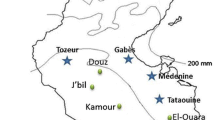Abstract
We have used total genomic DNA as a probe to size-fractionated restriction enzyme digests of genomic DNA from a range ofTriticeae species from the generaLeymus Hochst.,Psathyrostachys Nevski, andHordeum L., and hybrids betweenHordeum andLeymus to investigate their taxonomic relationships. Genomic Southern hybridization was found to be an effective and simple way to assess the distribution and diversity of essentially species-specific and common, repetitive DNA sequences, and is hence especially useful in evolutionary studies. The DNA sequences ofH. vulgare seem to diverge substantially from those ofH. brachyantherum, H. lechleri, H. procerum, andH. depressum. The genome ofThinopyron bessarabicum shows little homology to those of theLeymus species investigated, confirming thatT. bessarabicum is not an ancestral genome inLeymus. Although the genomes ofLeymus andPsathyrostachys share substantial proportions of DNA sequences, they include divergent repeated sequences as well. Hybridization with a ribosomal DNA probe (pTa 71) showed that the coding regions containing structural genes encoding the 18 S, 5.8 S, and 26 S ribosomal RNA were conserved among the species investigated, whereas the intergenic spacer region was more variable, presenting different sizes of restriction fragments and enabling a classification of the species. The rye heterochromatin probe pSc 119.2 hybridized to DNA fromH. lechleri andT. bessarabicum, but not to DNA from the other species investigated.
Similar content being viewed by others
References
Anamthawat-Jonsson, K., Heslop-Harrison, J. S., 1992: Species-specific DNA sequences in theTriticeae. — Hereditas116: 49–54.
, 1993: Isolation and characterization of genome-specific DNA sequences inTriticeae species. — Mol. Gen. Genet.40: 151–158.
, 1990: Discrimination between closely relatedTriticeae species using genomic DNA as a probe. — Theor. Appl. Genet.79: 721–728.
Bedbrook, J. R., Jones, J. D. G., O'Dell, M., Thompson, R. D., Flavell, R. B., 1980: A molecular description of telomeric heterochromatin inSecale species. — Cell19: 545–560.
von Bothmer, R., Jacobsen, N., Baden, C., Jorgensen, R. B., Linde-Laursen, I., 1991: An ecogeographical study of the genusHordeum. — Syst. Ecogeogr. Studies Crop Genepools 7. International Board for Plant Genetic Resources. — Rome: IBPGR.
Chao, S., Sharp, P. J., Worland, A. J., Warham, E. J., Koebner, R. M. D., Gale, M. D., 1989: RFLP-based genetic maps of wheat homoeologous group 7 chromosomes. — Theor. Appl. Genet.78: 495–504.
Dewey, D. R., 1984: The genomic system of classification as a guide to intergeneric hybridization with the perennialTriticeae. — InGustafson, J. P., (Ed.): Gene manipulation in plant improvement, pp. 209–270. — New York: Plenum.
Doebley, J., von Bothmer, R., Larson, S., 1992: Chloroplast DNA variation and the phylogeny ofHordeum (Poaceae). — Amer. J. Bot.79: 576–584.
Dvorak, J., Zhang, H.-B., 1992: Application of molecular tools for study of phylogeny of diploid and polyploid taxa inTriticeae. — Hereditas116: 37–42.
Flavell, R. B., Rimpau, J., Smith, D. B., 1977: Repeated sequence DNA relationships in four cereal genomes. — Chromosoma63: 205–222.
Friebe, B., Mukai, Y., Gill, B. S., Cauderon, Y., 1992: C-banding and in situ hybridization analyses ofAgropyron intermedium, a partial wheat ×Ag. intermedium amphiploid, and six derived chromosome addition lines. — Theor. Appl. Genet.84: 899–905.
Gerlach, W. L., Bedbrook, J. R., 1979: Cloning and characterization of ribosomal RNA genes from wheat and barley. — Nucl. Acids Res.7: 1869–1885.
Gupta, P. K., Fedak, G., Molnar, S. J., Wheatcroft, R., 1989: Distribution of aSecale cereale DNA repeat sequence among 25Hordeum species. — Genome32: 383–388.
Heslop-Harrison, J. S., 1992: Molecular cytogenetics, cytology, and genomic comparisons in theTriticeae. — Hereditas116: 93–99.
, 1990: Detection and characterization of 1 B/1 R translocations in hexaploid wheat. — Heredity65: 385–392.
Jacobsen, N., von Bothmer, R., 1992: Supraspecific groups in the genusHordeum. — Hereditas116: 21–24.
Jorgensen, R. B., 1986: Relationships in the barley genus (Hordeum): an electrophoretic examination of proteins. — Hereditas104: 273–291.
Leitch, A. R., Schwarzacher, T., Wang, M. L., Leitch, I. J., Surlan-Momirovich, G., Moore, G., Heslop-Harrison, J. S., 1993: Molecular cytogenetic analysis of repeated sequences in a long-term wheat suspension culture. — Pl. Cell Tissue Organ Culture33: 287–296.
Löve, A., 1984: Conspectus of theTriticeae. — Feddes Repert.95: 425–521.
McIntyre, C. L., 1988: Variation in isozyme loci inTriticeae. — Pl. Syst. Evol.160: 123–142.
, 1990: NewSecale cereale (rye) DNA derivatives for the detection of rye chromosome segments in wheat. — Genome33: 635–640.
Meinkoth, J., Wahl, G., 1984: Hybridization of nucleic acids immobilized on solid supports. — Anal. Biochem.138: 267–284.
Molnar, S. J., Gupta, P. K., Fedak, G., Wheatcroft, R., 1989: Ribosomal DNA repeat unit polymorphism in 25Hordeum species. — Theor. Appl. Genet.78: 387–392.
, 1992: RFLP analysis ofHordeum species relationships. — Hereditas116: 87–91.
Moore, G., Cheung, W., Schwarzacher, T., Flavell, R., 1991: BIS 1, a major component of the cereal genome and a tool for studying genomic organization. — Genomics10: 469–476.
Nagl, W., Knapp, B., Bill, O., 1991: The complex satellite DNA ofTropaeolum majus L.: Partial characterization of isolated and of cloned restriction fragments. — Ann. Bot.67: 347–355.
Ørgaard, M., 1992:Leymus Hochst. (Poaceae, Triticeae). — Studies of Relationships. — PhD Thesis. Royal Veterinary and Agricultural University, Copenhagen.
-Heslop-Harrison, J. S., 1993: Investigations of genome relationships inLeymus, Psathyrostachys, andHordeum inferred by genomic DNA: DNA in situ hybridization. — Ann. Bot. (in press).
Schwarzacher, T., Anamthawat-Jonsson, K., Harrison, G. E., Islam, A. K. M. R., Jia, J. Z., King, I. P., Leitch, A. R., Miller, T. E., Reader, S. M., Rogers, W. J., Shi, M., Heslop-Harrison, J. S., 1992: Genomic in situ hybridization to identify alien chromosomes and chromosome segments in wheat. — Theor. Appl. Genet.84: 778–783.
, 1989: In situ localization of parental genomes in a wide hybrid. — Ann. Bot.64: 315–324.
Swanson, C. P., Webster, P. L., (Eds) 1975: The cell. — New Jersey: Prentice Hall.
Zhang, H.-B., Dvorak, J., 1991: The genome origin of tetraploid species ofLeymus (Poaceae: Triticeae) inferred from variation in repeated nucleotide sequences. — Amer. J. Bot.78: 871–884.
Author information
Authors and Affiliations
Rights and permissions
About this article
Cite this article
Ørgaard, M., Heslop-Harrison, J.S. Relationships between species ofLeymus, Psathyrostachys, andHordeum (Poaceae, Triticeae) inferred from Southern hybridization of genomic and cloned DNA probes. Pl Syst Evol 189, 217–231 (1994). https://doi.org/10.1007/BF00939728
Received:
Revised:
Accepted:
Issue Date:
DOI: https://doi.org/10.1007/BF00939728




